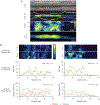Intravascular Molecular-Structural Assessment of Arterial Inflammation in Preclinical Atherosclerosis Progression
- PMID: 34419392
- PMCID: PMC8571057
- DOI: 10.1016/j.jcmg.2021.06.017
Intravascular Molecular-Structural Assessment of Arterial Inflammation in Preclinical Atherosclerosis Progression
Figures


References
-
- Azen SP, Mack WJ, Cashin-Hemphill L, et al. Progression of coronary artery disease predicts clinical coronary events. Long-term follow-up from the Cholesterol Lowering Atherosclerosis Study. Circulation. 1996;93:34–41. - PubMed
Publication types
MeSH terms
Grants and funding
LinkOut - more resources
Full Text Sources
Medical

